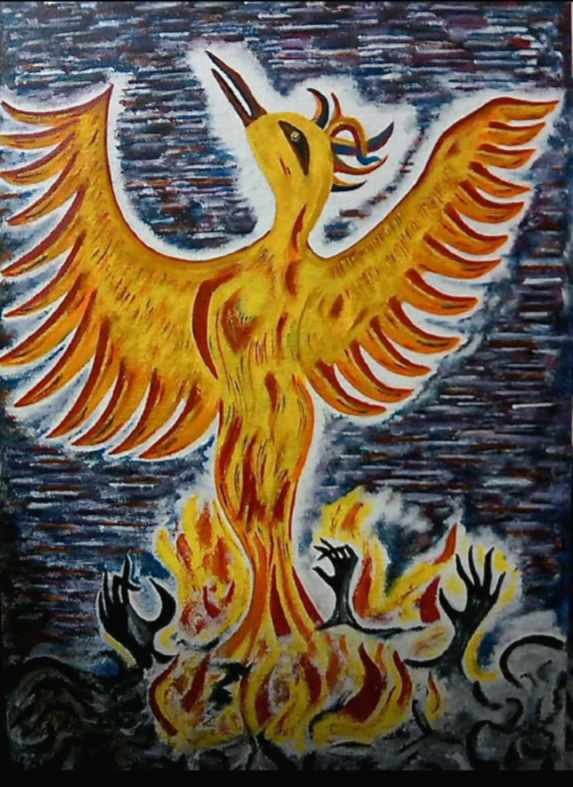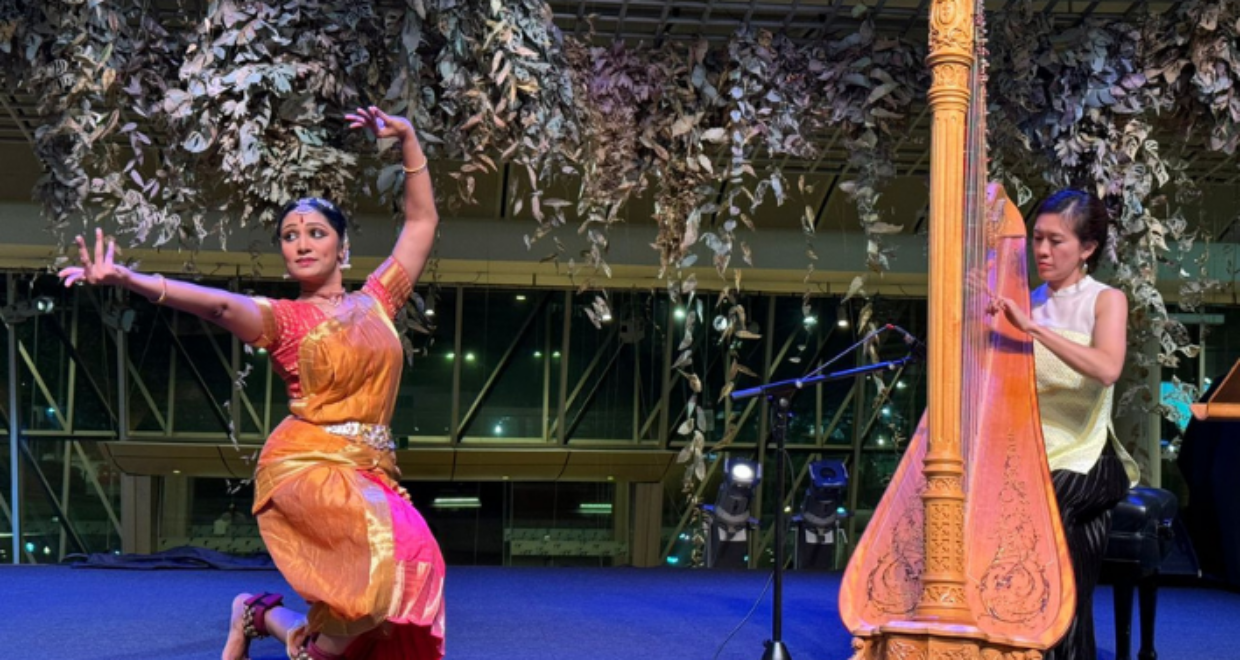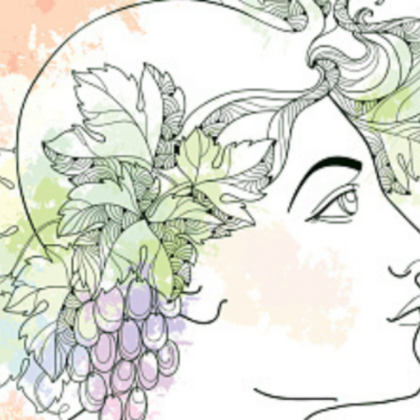Amma’s Dance
This edition of Muses – the arts blog from BJPsych International – features a crisscross of creative collaborations. Singapore-based music therapist/harpist Fontane Liang and consultant psychiatrist/dancer Dr Deva Priya Appan report on their musical and dance performance, Amma’s Dance, with additional contributions in prose and bespoke artwork by previous contributor to Muses, Dr Sravanti.

Amma’s Dance: From Flames of Anguish to Renewal
Artwork by Dr Lakshmi Sravanti
When Fontane suggested an artistic collaboration portraying the struggles of identity in modern motherhood to Priya, Priya entered the words ‘Bharatanatyam’ and ‘harp music’ into an online search engine. The search result was unsatisfactory, hence the realisation of creating everything from scratch. A herculean task, it seemed. But isn’t motherhood as well? From when a crying baby is placed in our hands, we fumble along the way, often uncertain of what we are doing. And so Amma’s Dance was born. Using their respective art forms to create a profound experience transcending words, the duo of Priya and Fontane express the emotions behind motherhood, highlighting the importance of identity, self-care and the role of the community in supporting parents.
Their experiences as mothers and their clinical experience as professionals guide their process, maintaining the core of each art form while exploring ideas that are more contemporary but relatable. Fontane used the English lullaby “Twinkle, Twinkle, Little Star” to introduce the phase of pregnancy, changing a single note to darken the mood, symbolising the initial doubt of a mother who realises that caring for a child is no easy feat. Gradually introducing other musical elements like atonality, irregular phrases, increasing speed and loss of pulse, the music symbolises the mother’s whirling mind: stress when the baby cries and refuses to sleep, confusion and conflict between traditional parenting advice from grandparents and modern parenting ideas from social media. The overwhelming pressure of the postpartum period is depicted with a cathartic rhythmic 5-beat dance. “Thaka Thakita” in the dancer’s feet is driven by the same rhythm on the harp. This builds to a frenzy before a psychic and musical collapse.
And yet, after the collapse comes the opportunity for renewal. Sravanti’s response to this dance was the image of the phoenix, symbolising resilience. A powerful reminder to mothers that they, too, need to renew and recharge themselves. A mother’s journey is not just about enduring the challenges of caregiving but about recognising the importance of self-care to continue nurturing others. The fire that consumes the phoenix represents the struggles, exhaustion and sacrifices that mothers often face. However, without the time and support to rest, rejuvenate, and rise anew, the cycle cannot continue.
An important aspect of the dance was audience participation. Deep breathing was introduced before the dance, and the audience joined in by breathing together with the overwhelmed mother to calm her down, indirectly sending the message that the community needs to be in sync with the new mother. Communities and loved ones play a crucial role in providing the emotional support and understanding needed for mothers—like the phoenix—to soar again, stronger and more vibrant.
The dance ended by revisiting the musical theme – a reminder of life before children. Priya dances the same dance in the beginning, but this time slower and carefully holding the child; the music weaves “Twinkle, Twinkle, Little Star” into the mother’s theme. Self-care for mothers is about remembering their identities as individuals; self-care is not a luxury; it is a necessity.
Affiliations
Dr Deva Priya Appan
- Consultant Psychiatrist Department of Child and Adolescent Psychiatry
- Institute of Mental Health (IMH)
- Singapore
- Email address: prappand@gmail.com
Fontane Liang
- Senior Music Therapist
- Department of Child and Adolescent Psychiatry
- Institute of Mental Health (IMH)
- Singapore
- Email address: fontane.liang@gmail.com
Dr Lakshmi Sravanti
- Assistant Professor
- Department of Child and Adolescent Psychiatry
- National Institute of Mental Health and Neurosciences (NIMHANS)
- Bengaluru, India
- Email address: drsravanti@yahoo.com
- ORCiD ID: 0000-0003-3979-9609
Welcome to Muses – the arts blog from BJPsych International. Launched in March 2022, this new blog aims to highlight international art and artists, particularly from low-and-middle-income countries, with a focus on mental health. We welcome submissions for consideration, such as, comments on artwork, visual arts, literature, drama, films, podcasts, and videos. Do have a look at the instructions for blog authors for details on how to submit. General enquiries about the blog: BJPInternational@rcpsych.ac.uk
Dr Marinos Kyriakopoulos, Editor-in-Chief, BJPsych International






This is an interesting experiment and innovation. It shows that even classical dances can be skilfully employed to depict the contemporary issues. It generates interest among audience and inspires them to adopt and/or adapt the ancient art forms to modern life. Such a classification may not there in any art form. It is done, however, for the convenience and suitability of the viewers and audience of the art. This is how people are fascinated by and involved in such performances. Analogy of phoenix is bound to enthral the human mind as everybody is reminded of unique ability of the bird to rise, soar again stronger and be more vibrant.